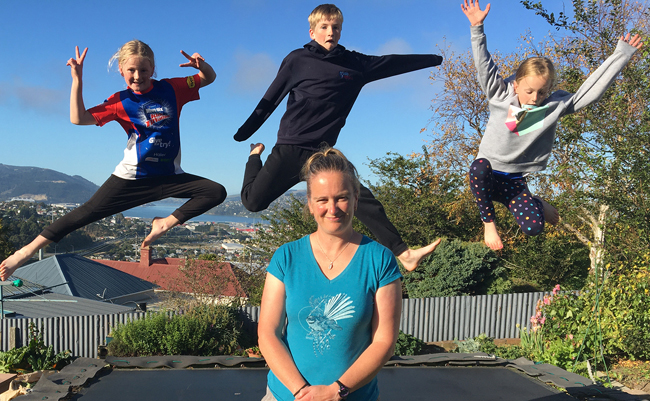Thursday 16 April 2020 1:25pm

Emily Scott at home with her children, from left, Hannah (10), Joshua (13) and Laura (8).
Emily Scott specialises in primary school physical education and is a Professional Practice Fellow and PhD candidate in the School of Physical Education Sports and Exercise Sciences.
As a mum of three and a previous secondary school physical education teacher, Emily is perfectly placed to offer some great guidance for how to get kids active, blow out some steam, and help stop everyone going stir-crazy during the lockdown.
However as Emily says these shouldn’t be the only goals for getting active.
“While we could see lockdown as a restriction on our movement, we could also see it as offering us a wonderful opportunity to explore, create, invent, discover and express ourselves, physically - to find movement that is personally meaningful, delightful and fun.”
Check out her nine top tips below!
1. Keep fun at the centre
Fun is a powerful motivator - way more than simply ‘because it is good for you’. Ever noticed how easy it is to get buy-in when the activity seems fun and enjoyable? Making up a ridiculous story while you go on a walk or scooter around the block might be enough to stop the boredom from setting in. Sock wrestling is another source of fun – winner is the one who can take off one of the other person’s socks. Children love to see their adults having fun too so don’t be shy about joining in and being able to laugh at yourself.
2. Let children create, make, invent, be in charge
When you have ownership over something, you are far more invested and it can take you on all sorts of interesting tangents. You never know what games are out there waiting to be discovered. Adding in a rule change or a different piece of equipment can make a familiar old game more interesting. Can you play backyard football with a tennis ball or an old tissue box or a balloon? What happens if you make naughts and crosses an active game? What game will your kids invent if you give them a bucket, a piece of newspaper and a ping pong ball? Can you play hockey in the hallway using the cardboard centre of a gladwrap roll? Obstacle courses give endless scope for creativity such as adding criteria like balance, rolling, bouncing, turning or jumping. And where is the strangest place you could play table tennis?
3. Follow their interests
When something is personally meaningful, we are far more inclined to pursue it and invest our energy in it. What do your children want to learn or be better at? Learning to juggle for instance is best achieved by starting with three bits of light fabric so the objects move more slowly in the air. Dust off the unicycle or the pogo stick in the garage and see if with some focused time and encouragement, they can master it. Children also love to see adults learning alongside them too but avoid anything that might lead you to A&E!
4. Take a trip down memory lane
What games did you enjoy as a child? This could be the perfect time to bring back four square or hopscotch. How about building some tin can stilts, or some sack racing or an egg and spoon race? Have you got any old school games in the cupboard like Bobs? Knucklebones or marbles? Some of these games are excellent for developing dexterity and hand-eye coordination which some feel is in steady decline. Teach your children skipping routines, or even double dutch if you have a couple of ropes.
5. Try something new
What about putting on a piece of music and making up a ti rākau (stick game) routine? Or poi? Learn to do a handstand. Can you build a mini golf course around your house and set up a tournament? What about a dance off or a family aerobics session? Or since we are missing out on the Olympics this year what about having your own family Olympics – straws make excellent javelins and a paper plate will suffice as the discus. Maybe it is time for a new Olympic event? What would it be?
6. Set a challenge
If you and your children respond well to challenges, how about setting some for yourselves? Can you put your t-shirt on, while upside down in a handstand against the wall? How many juggles can you do with a football? Can you run the whole way around the block? Can you build up to doing the splits? Who can do the longest wall sit? Draw a chalk target on an outside wall and see how close you can get to the centre with different sized balls.
8. Can be restful and quiet
Huffing and puffing isn’t the only way to be active. There is much to be gained from gentle stretching, focusing on breathing deeply and fully, steadying yourself and being still. These are excellent skills to develop in young people. Some people love yoga. Your walks around the neighbourhood can be unhurried, take time to listen and look. Pay attention. What a wonderful opportunity to truly connect and be present with each other rather than distracted by the next thing or the device in your hand.
9. Go easy on yourselves!
There is no need to panic about not doing enough or feel pressured into starting a new exercise regime for you and your bubble. You don’t need fancy gear or equipment or access to online exercise classes to make the most of this time. Children throughout history have had excellent capacity for inventing things to keep themselves occupied and practise skills with limited resources…think of the Pele and many Indian cricketers as examples. They will be OK and in fact, might look back on this time as one of the best parts of their childhood.
